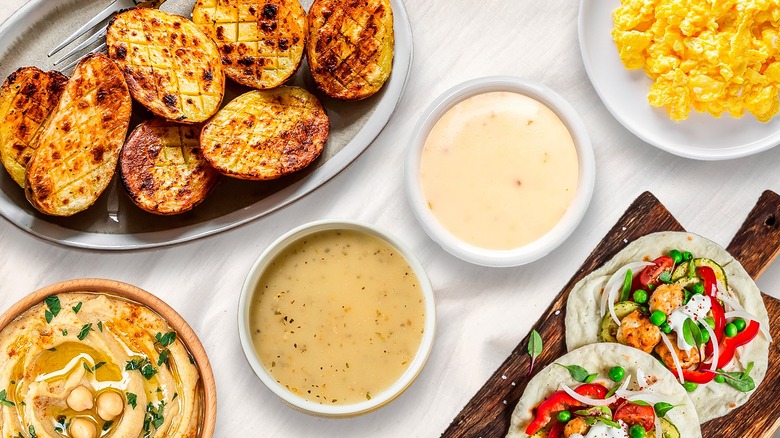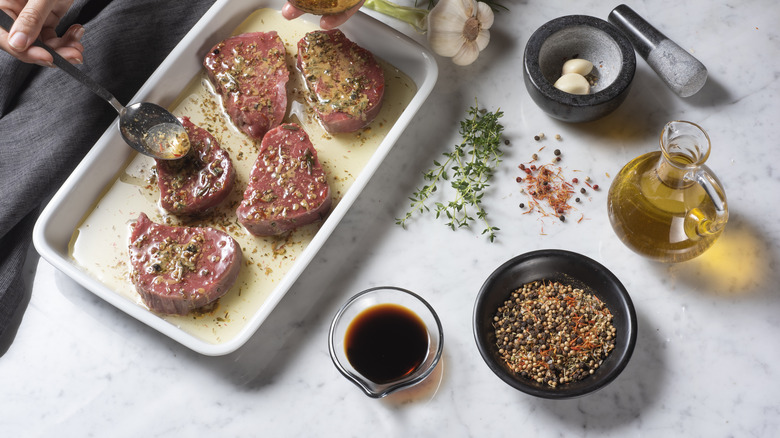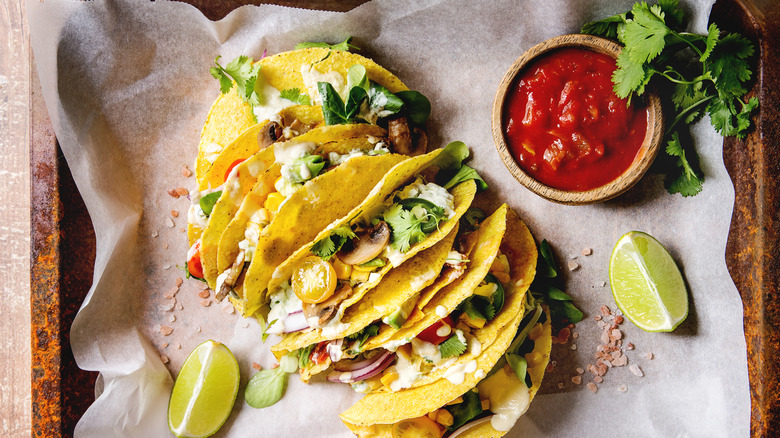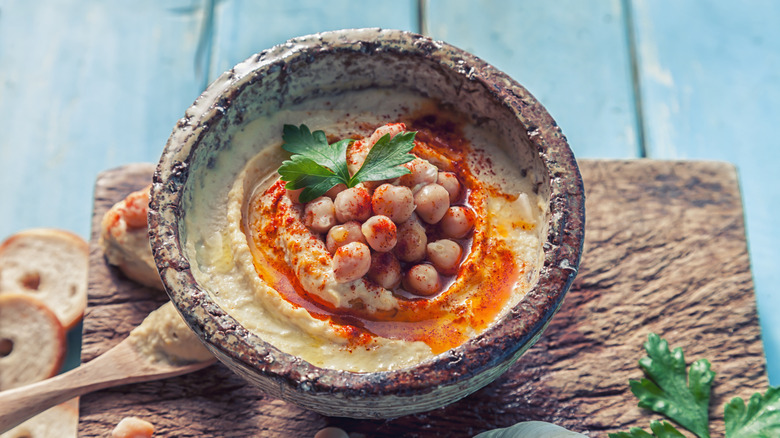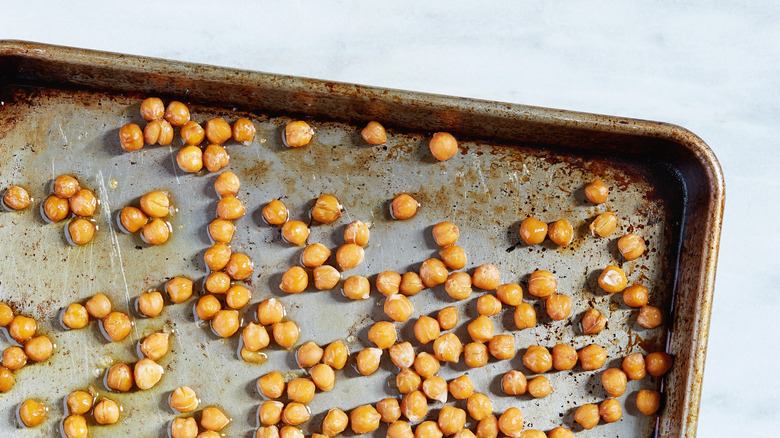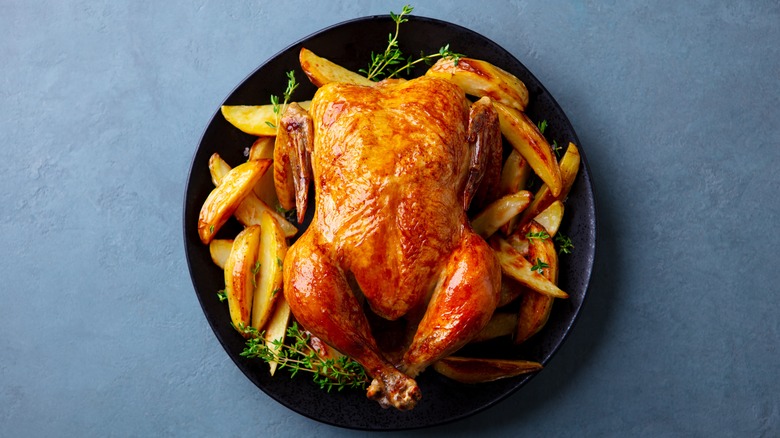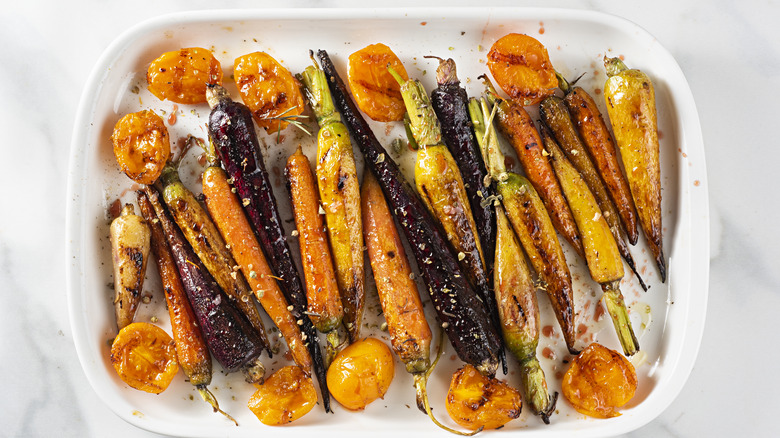14 Unexpected And Delicious Ways To Use Salad Dressing
It may come as a shock to veggie lovers everywhere, but not everyone loves a salad. For those who hear the word "salad" and envision chopped iceberg lettuce with whole cherry tomatoes, pre-shredded carrots, and red onion rings, then we can guess why salads may not be your first choice. A great salad has both crunchy and soft additions and should be heavy with toppings. Load up spicy dark greens with raw and roasted fruits and vegetables, proteins, herbs, seeds, and toasted nuts. However, the most important contribution to a salad is the dressing. If you're still not sold on our pitch for leafy greens, then ditch them! Luckily, there are plenty of unexpected and delicious ways to use salad dressing sans lettuce.
Now, salad dressings have quite a range, and there are endless flavorful salad dressing recipes out there. A delicate champagne shallot vinaigrette and a mayonnaise-based blue cheese dressing couldn't be more different. When using salad dressings outside of their normal capacity, it's important to specify what kind of dressing you're using. To keep things simple, place them in two categories: creamy dressings and oil-based vinaigrettes. Creamy dressings would refer to ranch, Thousand Island, blue cheese, Caesar, and Russian. Sometimes a tahini-based dressing falls into this category. An oil-based dressing typically refers to a vinaigrette containing some type of vinegar, citrus, or other acidic component.
Use as a marinade for protein
Whether you make your salad dressing yourself or spring for the store-bought stuff, there always seems to be a surplus sitting in the refrigerator. Grill masters, take note. An oil-based salad dressing like a vinaigrette, especially those with a citrus base, can make for an incredible poultry or fish marinade. Herb dressings like bottled Italian dressing work well for chicken and gamey poultry like quail or pheasants. A lemon base is fantastic for seafood, though shrimp tends to pair well with a lime-based dressing.
For red meat like steak, you can also use an Italian dressing. However, you have the option of a darker dressing like balsamic or soy sauce-based. Try using a plum or cherry balsamic for sweeter and richer notes. These stronger flavors of the balsamic don't overpower the robust flavor of red meat. Ingredients commonly found in dressing, like vinegar, lemon juice, and soy sauce, help break down the proteins or "tenderize" the meat. This is why they are also found in tenderizing marinades. Luckily, the two also usually contain garlic, spices, and herbs and can be quite flavorful when used as both a marinade and salad dressing. Any oil-based dressing, dark or light, also works for tofu and tempeh, which are quite versatile.
Create a stir fry sauce
Stir fry is elite — not just because it tastes delicious, but it's a great everything-but-the-kitchen-sink recipe to help you clear out your refrigerator. However, it's easy to get tired of your same old teriyaki stir fry. A great way to switch things up is to change the flavor profile by using a different sauce. That's right, you may have to stray from your go-to teriyaki, and that's okay. Try using your favorite oil-based salad dressing instead.
There are several ways you can include salad dressing in your stir fry. The first is by coating your wok in salad dressing for an incredible burst of flavor. The heat of the wok will help set those flavors and aromas free, seeping into your veggies and proteins. Another method is to add the dressing towards the end of the cooking process. This will ensure that the sugars won't stick to your pan.
For more traditional folks, try using a soy sauce or tamari-based Asian-style vinaigrette. This is one of the absolute best uses for tamari because it doesn't deserve to stand alone. Be sure to add acid like citrus or vinegar, aromatics like garlic and ginger, and a splash of oil. You can use a neutral oil, but be sure to add a little sesame oil into the mix for a deeper, richer flavor and mouthfeel.
In a taco
Taco Tuesday just got a whole lot more flavorful. It's time to step out of the box, and ditch that ground beef, iceberg lettuce, shredded orange cheddar trio to try something a little more daring. Each element of the taco should be rich in flavor. That means you should be seasoning just about everything from meat and veggies to toppings. In addition, it's always a good idea to add a sauce that boosts the taste even further. Toss your raw toppings in a little vinaigrette, or drizzle your taco with a spicy mayonnaise-based dressing.
If you're not sure where to start, try a lime vinegarette, a creamy cilantro dressing, or a three-ingredient sweet chili dressing. Anything with garlic should be considered. If you're using an oil-based dressing, try not to over-saturate your taco, and wait until the last minute to add it before serving. You wouldn't want to risk your taco becoming soggy, especially if you're using hard shells.
To enhance roasted potatoes
Potatoes are perhaps one of the most universally loved vegetables out there. They're sweet, creamy, subtle, starchy, and beyond delicious. Most importantly, they can be enjoyed in a wide variety of ways. One of the tastiest ways to enjoy potatoes is by roasting them. The exterior gets uber crispy while the inside becomes creamy and fluffy. But don't let the fun stop with salt and pepper. Spice those babies up! You can choose to drizzle your roasted potatoes with dressing after they have been roasted, use them as a dipping sauce, or toss them in an oil-based dressing before they make their journey into the oven.
If you're looking for a drizzle, you can choose from almost any dressing out there, although we recommend steering clear of anything super sweet like light raspberry vinegarette or French dressing. Creamy dressings like ranch or Russian dressing are fan favorites, but an herb-based vinegarette can do the trick as well. Thicker dressings are great for dunking, while oil-based dressings can lightly coat the raw potatoes before cooking. Just be sure not to go too heavy on the liquid, as the potatoes would likely steam instead of get crispy. In fact, utilize some tips to get the crispiest potatoes if you go this route, and consider tossing a little cornstarch onto the spuds.
Elevate your scrambled eggs
Now, if you're the scrambled eggs in the morning kind of person, then you might already know of the many tips for the world's fluffies scrambled eggs. One of the top tips is to add a little liquid to your eggs, but that doesn't mean you have to stick with water or milk. Try adding dressing to your eggs instead. Our top pick is ranch salad dressing because it enhances scrambled eggs by making them extra fluffy and extra creamy. Ranch dressing is loaded with herbs, and the tang of buttermilk enhances the flavor.
You can also use Italian or a soy sauce-based dressing. Whatever you choose, just don't add more than a tablespoon per two eggs to avoid a drippy and watery scramble. Simply whisk it right into the uncooked eggs, and proceed as usual by pouring it into a hot pan and stirring.
Garnish or make hummus
Nowadays, there is more to offer than just good ol' plain hummus. From lemon dill to chocolate, it seems like the hummus world is exploding with flavor. And honestly, we are here for it. There are a few different ways to incorporate dressing into your hummus, but our two favorites are fairly simple and effective.
First, you could mix the dressing right in if you're making hummus from scratch. We recommend a lemon, garlic, and oil-based dressing. Avoid a dressing that's too sweet, but a light hint of honey or maple syrup won't hurt. If the hummus recipe calls for olive oil, add it and then include just a tablespoon or two of dressing per full can of chickpeas. Don't think of replacing the olive oil with the dressing; it will be too overpowering.
You could also use the dressing as a garnish — like you would with extra virgin olive oil to decorate the hummus. Use a light drizzle, and stick to a vinaigrette. Feel free to use a chunky dressing that contains pine nuts, freshly minced herbs, olives, capers, or even chopped dates. Sticking to the Mediterranean theme is a safe way to experiment with flavor if you're feeling adventurous.
Flavor roasted chickpeas
Who doesn't love a salty, crunchy snack? If you're sick and tired of potato chips or are looking for a more nutritious alternative, look no further than roasted chickpeas. They are loaded with protein, fiber, and iron, making for a healthy snack. Beyond snacking, they can be added to salads, grain bowls, and pretty much any meal that needs a savory crunch. Air-fried chickpeas are easy to make, but you can also roast them in your oven.
Before cranking up the heat and popping them in, toss them in a little dressing. Now, you must dry out the chickpeas beforehand using a paper towel or cloth. This step is essential to obtain that crispy crunch. Use just a tiny bit of dressing, whether it's oil-based or cream-based. Too much will result in soggy chickpeas. Remember, you can always drizzle them with ranch or a herby vinaigrette after they cook. Finally, use a little cornstarch to soak up that extra liquid from the dressing. You'll get a flavorful and healthy snack.
Bring depth and flavor to roasted turkey
Roasted turkey seems to make an appearance only once a year, and that's a shame. Poultry lovers should consider making it more often, but if you are waiting for the chill in the air to buy your yearly turkey, then make it count. Don't stick to the same old recipe, try something new. After brining your turkey, rub it down with some herby, garlicky vinaigrette. Not only will the slight sweetness of the vinegar help the flavor pop, but it will add a subtle sweetness and caramelization to the skin. The oil will enhance the crispiness of the skin, and the garlic and herbs will add layers of depth and flavor.
Don't forget about rubbing a little dressing on the inside of the bird, too. All of the drippings will taste that much better with the enhancement of a herby vinaigrette. After giving this a try, you may just find yourself adding turkey to the menu more often.
As a sandwich spread
A good sandwich should leave a mess. Your plate and fingers should need licking, and the sauces and juices should drip down your elbows. Use juicy cuts of meat, marinated vegetables, sauce-soaked tofu, dripping melted cheeses, sandwich spreads, and, of course, sauce. For your sauce, use up that leftover salad dressing. Any and all dressings will do — just coordinate your flavors with the other toppings of the sandwich.
If you have a tangy or spicy sandwich, then opt for something to cool the tongue, like ranch dressing. If you are going veggie-heavy, choose a vinaigrette to help those flavors sing. Honey mustard pairs well with almost any meat, and Thousand Island deserves a spot in almost any burger. Blue cheese dressing pairs well with roast beef and other red meats, while a lemon-based vinaigrette might be best on a grilled fish or chicken sandwich. When in doubt, go with a classic, like adding ranch to your chicken bacon wrap or oodles of Caesar dressing to your chicken Ceasar wrap.
Mix it into your veggie burgers
Veggie burgers are all the rage. And we aren't talking about Impossible meat or Beyond Burgers. These are good old-fashioned burgers made from fresh vegetables, grains, nuts, and spices. If you haven't mastered the art, then you're not alone. Folks struggle with getting the right consistency, choosing ingredients, and masting the flavorings. There are many ways to add flavor to vegetarian burgers, but one of the simplest ways is to include pre-made condiments and sauces like barbecue sauce or Worcestershire. The overlooked sauce that should make its way into your next batch of veggie burgers is salad dressings.
Yes, salad dressings can make for an incredible burger sauce, but mixing it right in is elite. You don't have to suffer dry veggie patties anymore. If you're finding that your recipe keeps coming out like cardboard, you may need to add extra liquid. Never add water — it's a missed opportunity for flavor. Choose any of your favorite dressings, like Italian, garlic herb, balsamic, or even a soy sauce-based dressing. Avoid creamy dressings, and be sure to add a tablespoon at a time until you reach the perfect consistency.
Flavor lentils
If you don't like lentils, maybe you don't know how to flavor them. They must be treated like tofu or even chicken. When was the last time you enjoyed a plain slab of tofu or unseasoned chicken breast? This is why not adding flavorful ingredients to lentils is a big mistake. A little vegetable broth can usually help during the cooking process, but once they are cooled and ready to eat, there is no better way to flavor them than with vinaigrette.
The combination of oil, vinegar, spices, and dijon makes for an intriguing flavor that can be enjoyed hot or cold. Mix a few tablespoons into a quart of cooked lentils, and use them stuffed inside a squash, over a grain bowl, or on their own as a side dish. This will bring your lentils from bland to boring with minimal effort. Use a sherry vinaigrette or one containing shallots for an extra sophisticated, gourmet appeal.
Season grains
Grains are mild and starchy, and that's why we love them. They help absorb the sauce from your stir fry or the drippings from your steak. Even when their job is to make the main portion of your dish shine, grains should be seasoned. It will help you get the most from your sidekick grain. Try using dressing to season your grains after they have been cooked. A light vinaigrette will do the trick — just don't oversaturate your grains.
It can work with more than just rice. Try it with quinoa or even oats to make the oh-so-trendy savory steel-cut oats. You can also flavor them by adding a little bit of dressing to the water as they cook. Be sure to use fresh citrus like lemon, which is the star ingredient of Ina Garten's vinaigrette. A classic rice seasoning contains many similarities to dressing already. The vinegar, sugar, and oil all work together to make a simple rice seasoning or salad dressing.
Elevate roasted veggies
Instead of having an internal argument about what to have for dinner, turn to a sheet pan recipe. They require minimal effort and can be quite healthy. Use up those leftover veggies hiding in the back of your refrigerator. Any chopped meat or tofu can be tossed right on the pan, too. Drizzle the whole thing with an oil-based dressing and pop them in the oven.
Vinaigrette is the secret ingredient to roasted vegetables. The vinegar helps those veggies shine without too much additional salt. That zing of flavor coupled with the subtle sweetness from the vinegar is what most vegetarian dishes are missing. The oil will keep those veggies moist on the inside and crisp on the outside. The sugars will caramelize, and you'll be left with a dish to remember. Enjoy over seasoned grains, or on their own as a side dish or main event. But why stop there? You can even use vinaigrette to season grilled vegetables. Just be sure to follow our top tips for grilling vegetables so they don't end up soggy and limp.
Use as a dip for pizza crust
Do you ever notice that after your friends and family go to town on a box of pizza, there are always at least a few uneaten crusts left over? But who can blame those who toss the crust aside? Eating plain bread without so much as a little butter or olive oil would be considered unnatural in any other capacity. Those leftover crusts deserve to be dipped and dunked.
Use any dressing you please. There are no rules here. Almost every dressing can be considered the absolute best sauce for dipping your pizza crust, from ranch to balsamic vinaigrette and lemon pepper dressing. The more the merrier — line up those dressings in little dishes and let your guests choose their poison. Dipping sauces works especially well with gluten-free pizza crusts that might not be the tastiest part of the pizza. Once it's loaded up with sauce, who can tell the difference?
